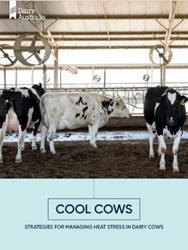Managing in Hot Conditions
In cooler climates, hot weather events are not as common but they do happen.
When hot weather events happen, they are usually forecast 5-7 days in advance.
There are some simple management steps that can be taken to minimise the effects of these events on herd production.
Access to cool drinking water
Allow for 200-250 litres per cow per day of drinking water in hot weather – double what cows usually need each day. Make sure cows have access to plenty of cool drinking water wherever they are during the day.
A large water trough on the exit side of the dairy allows cows to consume water at their leisure.
Water troughs in every paddock will keep cows grazing longer in hot weather. The less distance they have to go to water reduces the chance of them stopping grazing due to the heat.
Large volume concrete troughs help keep drinking water cool.
High flow rates are essential. Water pipes should be 75 mm in diameter. There needs to be sufficient pressure to provide 20 litres per cow per hour
Avoid running black polyethylene pipe along the ground as water will become very hot.
Milking times
Walking cows to the dairy during the hottest part of the day (about 3pm) adds to their heat loads.
Delaying afternoon milking until 5pm may increase milk yield by up to 1.5 litres per day, regardless of whether the cows are sprinkled with water while in the dairy.
Be sure to milk and feed cows before 10am on hot days. Have it done by 9am on heat wave days. Look for ways to offer feed to cows as soon as they exit the dairy. Have the paddock or feed-out area ready and ensure that every cow adequate access.
Paddock rotation
It is useful to have a rating for all paddocks based on distance from the dairy and amount of shade available. When high heat and humidity periods are forecast the paddock rotation can be adjusted to minimise walking and maximise shade available.
During summer when there is minimal paddock feed available consideration needs to be given to whether the cows need to go to the paddock during the day. The use of sacrifice paddocks and feed pads will help to minimise heat exposure.
Care needs to be taken to avoid excess paddock contamination in sacrifice paddocks. This will increase the risk of mastitis and milk quality issues. Ensure any stand-off areas have plenty of access to water with high flow rates into the trough.
